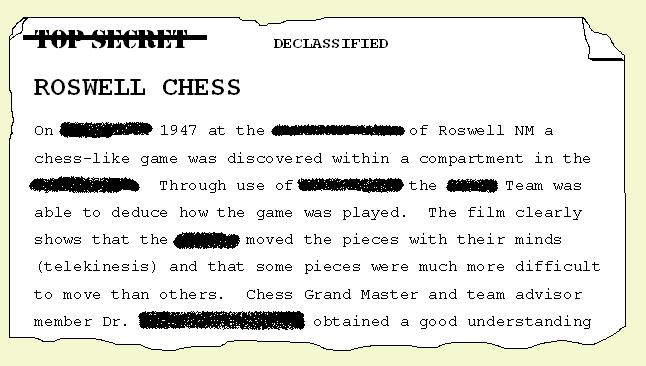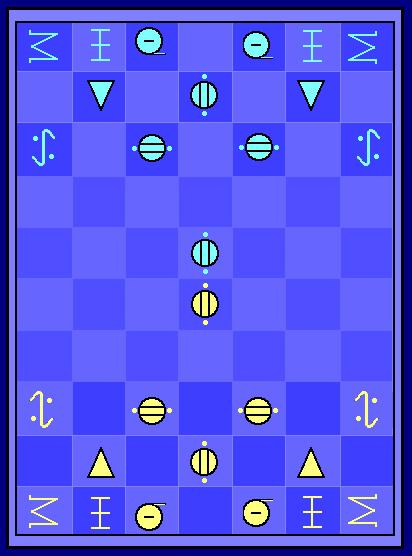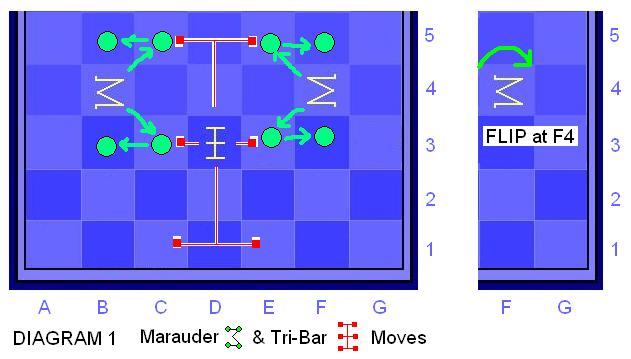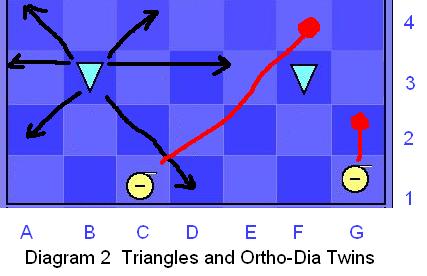Roswell Chess
by Gary K. Gifford, August, 2006
 The true name of the game is not known, but I have chosen to call it “Roswell Chess†after the location in which it was found. It does not appear to be a game for humans. For one thing, to play the game correctly one is to move the pieces with his or her mind via telekinesis. For another, the game appears to offer little or no enjoyment to humans.
The true name of the game is not known, but I have chosen to call it “Roswell Chess†after the location in which it was found. It does not appear to be a game for humans. For one thing, to play the game correctly one is to move the pieces with his or her mind via telekinesis. For another, the game appears to offer little or no enjoyment to humans.
Setup

Pieces
Pieces: The actual names of the pieces remain unknown. The “Team†used the following names and keyboard designations.
M – Marauder. Move as indicated by their vectors (see Diagram 1); this is deemed a “normal†move. A Marauder can capture on one or two spaces by making (a) a diagonal move in the direction of its slope followed by (b) an orthogonal move back towards its associated M-leg (see diagram). If a diagonal is occupied by a friendly piece, the Marauder cannot move on that leg of the “M.†In the diagram below, if enemy pieces were on B3 and C3, the left-hand Marauder could capture both pieces. If an enemy piece were on F5 and E5 was void of a friendly piece, then the Marauder could capture on F5. Instead of making a normal move, Marauders can perform a horizontal 180 degree flip. They would remain on the same square when flipping (see diagram, Marauder (on F4)before and after a flip.
 I - Tri-Bar. Looks like an “I†with 3 horizontal bars. They can move as indicated by their vectors (see Diagram 1). They can leap like a Knight in chess forward or backward, or can step one space left or 1 space right.
O_ - Ortho-Dia Twins. Located just left and just right of the center file at the start of the game. These move like Queens and they move simultaneously. When one moves diagonally the other must move orthogonally; and visa versa. They need not move the same number of spaces. To capture they must both come to rest on empty spaces adjacent to the piece being captured. Upon capturing a piece either one of the Ortho-Dia Twins has the option to immediately return to any empty squares on its owner’s first two rows. Diagram 2 shows an Ortho-Dia capture. When one twin is captured the other turns into a Tri-Bar. If it is not on the owner’s first rank it MUST be relocated to the owner’s first rank immediately, regardless of whether or not this is desirable. If it is already on the first rank it can be moved to another vacant square on the first rank, if available. Should no available first rank space exist, the lone twin is removed from the board.
I - Tri-Bar. Looks like an “I†with 3 horizontal bars. They can move as indicated by their vectors (see Diagram 1). They can leap like a Knight in chess forward or backward, or can step one space left or 1 space right.
O_ - Ortho-Dia Twins. Located just left and just right of the center file at the start of the game. These move like Queens and they move simultaneously. When one moves diagonally the other must move orthogonally; and visa versa. They need not move the same number of spaces. To capture they must both come to rest on empty spaces adjacent to the piece being captured. Upon capturing a piece either one of the Ortho-Dia Twins has the option to immediately return to any empty squares on its owner’s first two rows. Diagram 2 shows an Ortho-Dia capture. When one twin is captured the other turns into a Tri-Bar. If it is not on the owner’s first rank it MUST be relocated to the owner’s first rank immediately, regardless of whether or not this is desirable. If it is already on the first rank it can be moved to another vacant square on the first rank, if available. Should no available first rank space exist, the lone twin is removed from the board.
 In Diagram 2 the blue Triangle on B3 protects [a useless protection] the other blue Triangle on F3. However; The Ortho-Dia Twin on C1 moves diagonally to F4. Its twin, ON THE SAME TURN, moves to G2 and the Blue Triangle on F3 is captured. Upon capturing a piece either one of the Ortho-Dia Twins can immediately return to any empty square on its owner’s first two rows; or both can stay at their new location.
/\ - Triangle. These always point towards the opponent. They capture by displacement. Movement can be horizontal along their current row as suggested by their base (a horizontally-limited rook). Movement can also be as a Bishop’s diagonal move in standard chess as suggested by their two angles. Diagram 2 includes a Triangle movement example.
Ov – V-Shield (Vertical Shield). A circle with 2 vertical bars and 2 dots. Vertical Shields are confined to the center file. They can move up or down like a vertically-restricted rook. They cannot be captured and they cannot make captures. They serve to block. They cannot pass other shields in their path.
Oh – H-Shield (Horizontal Shield). A circle with 2 horizontal bars and 2 dots. Horizontal Shields are confined to their owner’s third rank. They move left or right like a horizontally-restricted rook. They cannot be captured and they cannot make captures. They serve to block. They cannot pass other shields in their path.
S – Waveform. Resembles a waveform and two dots. These move like Kings in chess. When one is captured, the side making the capture gets to add a Marauder to any free space on their last rank or first rank (their choice). When a player losses his (or her) second Waveform, he (or she) losses the game.
In Diagram 2 the blue Triangle on B3 protects [a useless protection] the other blue Triangle on F3. However; The Ortho-Dia Twin on C1 moves diagonally to F4. Its twin, ON THE SAME TURN, moves to G2 and the Blue Triangle on F3 is captured. Upon capturing a piece either one of the Ortho-Dia Twins can immediately return to any empty square on its owner’s first two rows; or both can stay at their new location.
/\ - Triangle. These always point towards the opponent. They capture by displacement. Movement can be horizontal along their current row as suggested by their base (a horizontally-limited rook). Movement can also be as a Bishop’s diagonal move in standard chess as suggested by their two angles. Diagram 2 includes a Triangle movement example.
Ov – V-Shield (Vertical Shield). A circle with 2 vertical bars and 2 dots. Vertical Shields are confined to the center file. They can move up or down like a vertically-restricted rook. They cannot be captured and they cannot make captures. They serve to block. They cannot pass other shields in their path.
Oh – H-Shield (Horizontal Shield). A circle with 2 horizontal bars and 2 dots. Horizontal Shields are confined to their owner’s third rank. They move left or right like a horizontally-restricted rook. They cannot be captured and they cannot make captures. They serve to block. They cannot pass other shields in their path.
S – Waveform. Resembles a waveform and two dots. These move like Kings in chess. When one is captured, the side making the capture gets to add a Marauder to any free space on their last rank or first rank (their choice). When a player losses his (or her) second Waveform, he (or she) losses the game.
Rules
As indicated in the piece section. Plus:
On each turn a player can:
(a) Move any one of his 4 shields. Remember, shields cannot capture or be captured.
(b) Move a non-shield piece. A non-shield piece must be Moved.
Note that (a) and (b) can be performed in either order. However, move (a) is optional, move (b) is required.
Note: If an Ortho-Dia Twin moves, then its twin must also move on that same turn. But, you could, for example, move an Ortho-Dia Twin, Move a Shield, then move the second Ortho-Dia Twin as this is all within a single turn.
There are no checks, checkmates, or stalemates.
Win by capturing your opponent's two Waveforms.
Notes
The truth behind this game. I was given a copy of a book entitled, “UFO UPDATE FALL of ’95.†Its previous owner offered it for sale at a garage sale for 50 cents, but could find no buyers. Thus I inherited it. Upon flipping through the pages I saw drawings of Rosewell Film Hieroglyphics (One which resembled a Shogi King) and I saw a Roswell Report with lots of words, lines, paragraphs, and even complete pages blacked out. This was the version of the report which was “DECLASSIFIED†and released to the public. Of course, it is the blacked-out stuff that I want to read. Anyway, I got to thinking, what if it was no weather balloon that dropped down in Roswell back in 1947? What if there really were aliens and they had a game on board their ship? What if… ? And so I bring you this game… a game which I imagined bug-eyed aliens moving pieces via telekinesis (with their own brain-wave power).
Roswell Chess (c) August 2006 by Gary K. Gifford
 This 'user submitted' page is a collaboration between the posting user and the Chess Variant Pages. Registered contributors to the Chess Variant Pages have the ability to post their own works, subject to review and editing by the Chess Variant Pages Editorial Staff.
This 'user submitted' page is a collaboration between the posting user and the Chess Variant Pages. Registered contributors to the Chess Variant Pages have the ability to post their own works, subject to review and editing by the Chess Variant Pages Editorial Staff.
By Gary K. Gifford.
Web page created: 2006-08-08. Web page last updated: 2006-08-08
 This 'user submitted' page is a collaboration between the posting user and the Chess Variant Pages. Registered contributors to the Chess Variant Pages have the ability to post their own works, subject to review and editing by the Chess Variant Pages Editorial Staff.
This 'user submitted' page is a collaboration between the posting user and the Chess Variant Pages. Registered contributors to the Chess Variant Pages have the ability to post their own works, subject to review and editing by the Chess Variant Pages Editorial Staff.